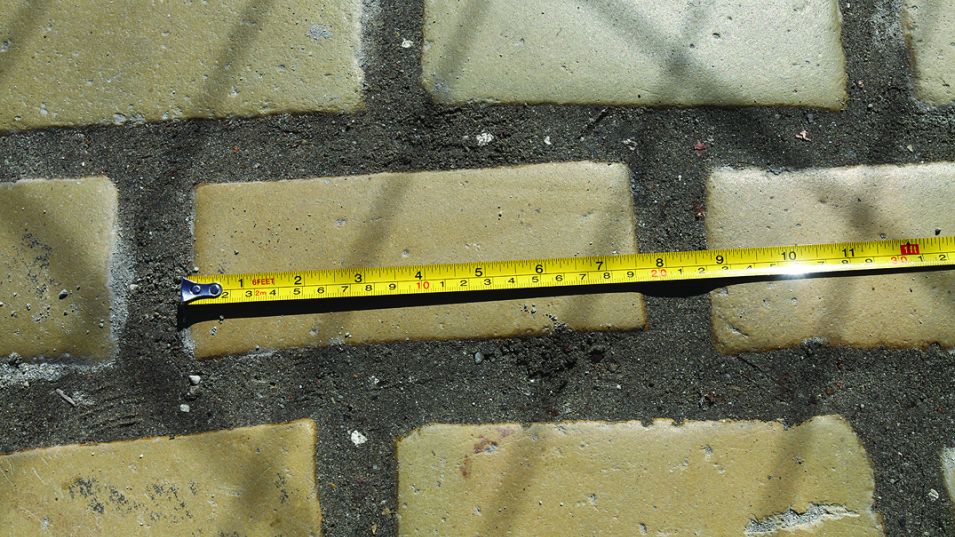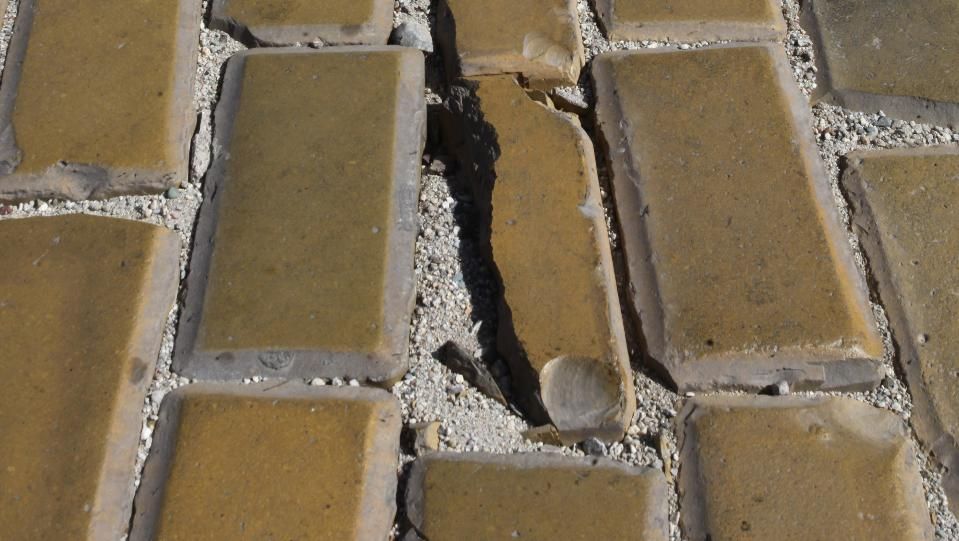The Institute for Cultural Heritage has ordered to pour sand between the ceramic blocks
Engineers in front of Trud News: According to the project, the bitumen had to be poured
Officials gave advice to builders
The National Institute for Immovable Cultural Heritage (NIHN) at the Ministry of Culture is responsible for the compromised repair of yellow pebbles in Sofia. This was established by an inspection by “Trud News” after it became clear that the mayor of the capital, Yordanka Fandakova, had referred to the prosecutor for broken blocks and the municipality will sanction the contracting company for the poor quality of the flooring in the center by Sofia.
“Trace Group Hold” has apparently destroyed many of the precious pebbles.
“Trace Group Hold” JSC signed on July 13 this year a contract for the restoration and renovation of public spaces in the central part of the city of Sofia, worth BGN 16,572,892.06 excluding VAT. Throughout the summer, however, Acting Minister of Culture Velislav Minekov and his wards paid no attention to this major renovation for Sofia. In addition, department officials gave advice and orders to builders on how to rearrange the pavers.

This is what a standard yellow pavement looks like, about 22cm long and 11cm wide with a 1cm gap. This order was preserved around the National Theater “Ivan Vazov”.

And these are the cobbles in front of the parliament rearranged by “Trace Group Hold”, which are different in size from the original ones. The builders still have to answer what the truth is.
It turns out that NINKN has provided repair instructions to be done using genuine sand-only technology. Thus, the paving stones literally became mobile due to the huge traffic of vehicles, the construction company explained.
According to the project, bitumen had to be poured between the paving slabs, which would have played the role of reinforcing the pavement and would not have allowed the movement of the ceramic blocks. Similar technology was used in previous repairs, but this time the National Institute of Public Health and Safety was adamant that nothing but sand should be placed.
However, the result turned out to be crooked rows of yellow pavers, huge joints in places, and hundreds of angry comments on social networks.
Engineer Krasimir Tsoklinov from “Trace Group Hold” to “Trud News”: bitumen has been used as a binder since 1955

– Mr. Tsoklinov, why are the joints between the yellow paving stones in Sofia so large in places, reaching up to one centimeter?
– Since the paving stones have shifted, the joints were not large at first. There are pictures for that. The intersection is not repaired, there are large joints, it has also opened, it pulls, nothing stops it and they open.
– According to some, if the pebbles were better arranged, there would be nowhere to move.
– If they are that great specialists, come and fix them. It is one thing to say, another is to do. After all, the technology is with sand and it is authentic, as requested by the National Institute of Real Estate Cultural Heritage. There is no binder in the sand.
– In the original, initial form, were the paving stones with resins glued together?
– In the original form, when they were made, the movement took place on foot and with chariots and fetons. If we bring back the wagons and carriages or make the journey on foot, the sand will be fine.
– Now, when you rearrange the pavers, will the sand be used again?
– I do not know.
– Didn’t you specify how they will be rearranged?
– We talk to various experts, they give different opinions. For sure, it probably won’t be with the sand. But this should also be welcomed by the National Institute for Real Estate Cultural Heritage.
– Are the pavers treated in any way to prevent them from slipping? After the rearrangement they seem to have lost their shine, not so shiny.
– No. In some places, the paving stones themselves have simply been turned upside down. In the beginning, when these pavers were produced, they had some traction. Where possible we have turned them upside down because underneath they are not consumed, they have not been used. The idea is to have some traction because it’s a slippery surface, we all know that. Not everywhere they are reversed, where we have been successful, they are reversed.
– When do you think the rearrangement starts?
– I can’t tell you yet. There is a 1960 article in “Sofia” magazine. There, the engineer Simeonov recommended filling the joints with bitumen. In 1955 they began to fill them with bitumen. Apparently they too have had their problems from the increase in traffic. And so they used a binder to avoid having these problems.
Sofia Mayor Yordanka Fandakova: Destruction of cultural value is a crime

In the contract we have with the contractor, penalties in the amount of BGN 830,000 for poor performance are included. Of course, there are also severe penalties for delay. They can be imposed at the end of the performance. To say that sanctions can be imposed now is to save the company because it will not stand up in court. As before, I have not made any compromises with contractors.
Just for information – there is a list of penalties imposed under various contracts with the “Trace” alone – amounted to over BGN 2 million in the last year. In the latest decision, confirmed by the court, it is a penalty imposed on the basis of an ongoing repair contract in the amount of BGN 738,000. This is nearly one million BGN and it’s not just for the Trace company. We impose these penalties on a daily basis on all companies that do not do their job and ask that no suggestions be made to spare anyone. What do I foresee to ensure that the reordering is of quality? First, I requested resampling of the moved sections. Second: to form a council of experts, in which we invite the best specialists in Sofia to give their opinion on the way to order, but also experts from abroad, from the cities with which we work in good cooperation.
I expect the expert council to recommend a solution, which, of course, will then be coordinated with the National Institute for Cultural Monuments. I just remind you that in 2016 the yellow pavements were declared cultural value. The violation and destruction of cultural value is not only unacceptable, it is a crime under the criminal code and I have filed the case with the prosecutor.
This section for the rearrangement of yellow pavers is 5 percent of the total contract, which in turn is around BGN 17 million. The general contract covers all of Area 4. This is the most iconic site we manage and I will not allow the symbol of our city to look like this.
Vezhdi Rashidov, former Minister of Culture: Those who destroyed cultural values today declare themselves their guardians

The yellow paving stones were commissioned by Austria-Hungary on the initiative of the then mayor of Sofia, Martin Todorov, and were laid in 1907. They are ceramic, extremely resistant, and are a symbol of the capital’s center.
While I was Minister of Culture, by order of December 2016, the flooring in Sofia, laid before 1944, was declared an immovable cultural property with a certain regime of temporary protection. Subsequently, the paving slabs along “Dondukov” were replaced with asphalt pavement. While we remove the cobblestones from our streets, the Austrians buy them and pave their streets.
Bulgaria has a number of yellow pavers in stock. This quantity was also ordered in Hungary so that repairs could be carried out. When renovating, the hardest part is the corners next to the curbs that need to be cut to complete the flooring.
If the repairs don’t go well, things should be fixed. There are institutions that will tell you how.
As for Angro speaking, it is an exaggeration to say that there has been a profanation. There was a desecration when the protesters removed the paving stones, crushed them and threw them. Responsibility must be sought by the people who then destroyed cultural values and who today declare themselves to be their guardians.
Krasimir Angelov, sculptor: The yellow cobbles are the face of our city

The yellow pebbles are the face of our city. They are a solution that makes Sofia different from other cities.
Every street in the world is repaired, just like the streets of our capital. Repairs are mandatory and during the repair it is not possible that some of the stones will not be cut to complete the repair professionally.
As for the desecration of cultural values, this is a crime we have witnessed over the years.
From the Facebook profile of Vili Lilkov, former city councilor
How the artisans of the thorns arranged them 115 years ago

Hey guys, at the beginning of the 20th century, yellow pavers were being laid by the “masters of thorns”. So take it and read how they made it, what materials they used and if you don’t bring it according to their recipes, you are useless! That is why I will help you – the archives for the yellow pavers are located on “Moskovska” – 300m from the Municipality. Read them:
“400 tons of cement, 45 tons of tar, 24 tons of resin, 600 cubic meters of gravel and 1,400 cubic meters of sand were used to lay 12,600 square meters of yellow pavement.” It is also described how they are placed on a support of concrete, pebbles or sand; which hammers and shovels are used; which sands are used; what kind of gravel; how the joint compound is made; what their cement, tar and resin are for; in what stages is it flooded; that the “hand” images were drawn for “ignorant” masters. Let me remind you that yellow pavers have been “working” for more than 115 years and, according to the initial estimate, their lifespan is 60-70 years and every year 0.3% of them need to be replaced and there is none. a single new pavement.
And one more thing, in 1909, for six months the mayor of Sofia did not pay for the work of the Bulgarian industrial ceramic company “Izida”, which perfectly carried out its work of laying yellow flooring, and you know why – because they did it does not pay state and municipal taxes and December 15 this year gives them five days to do it and then wait for the money!


